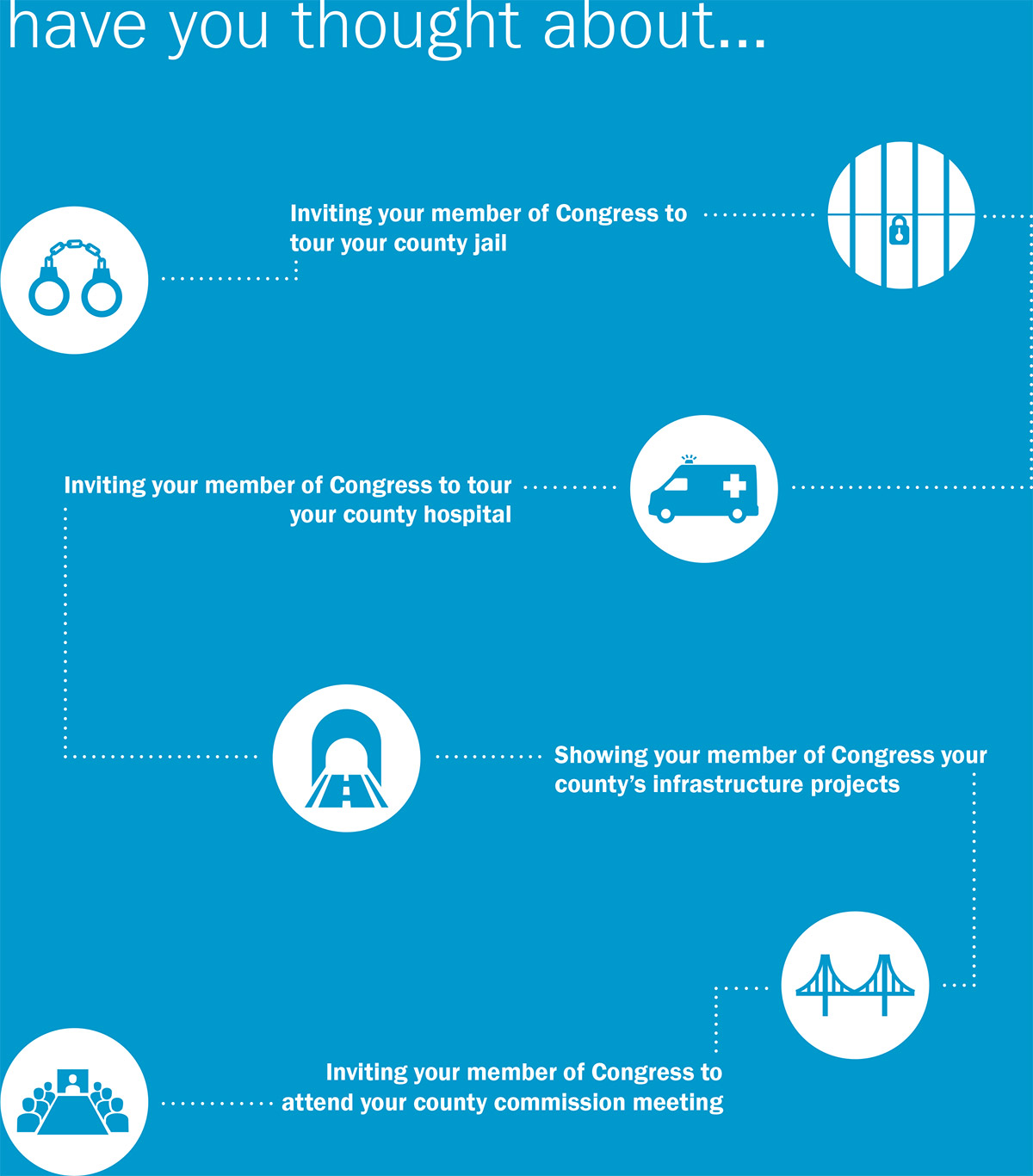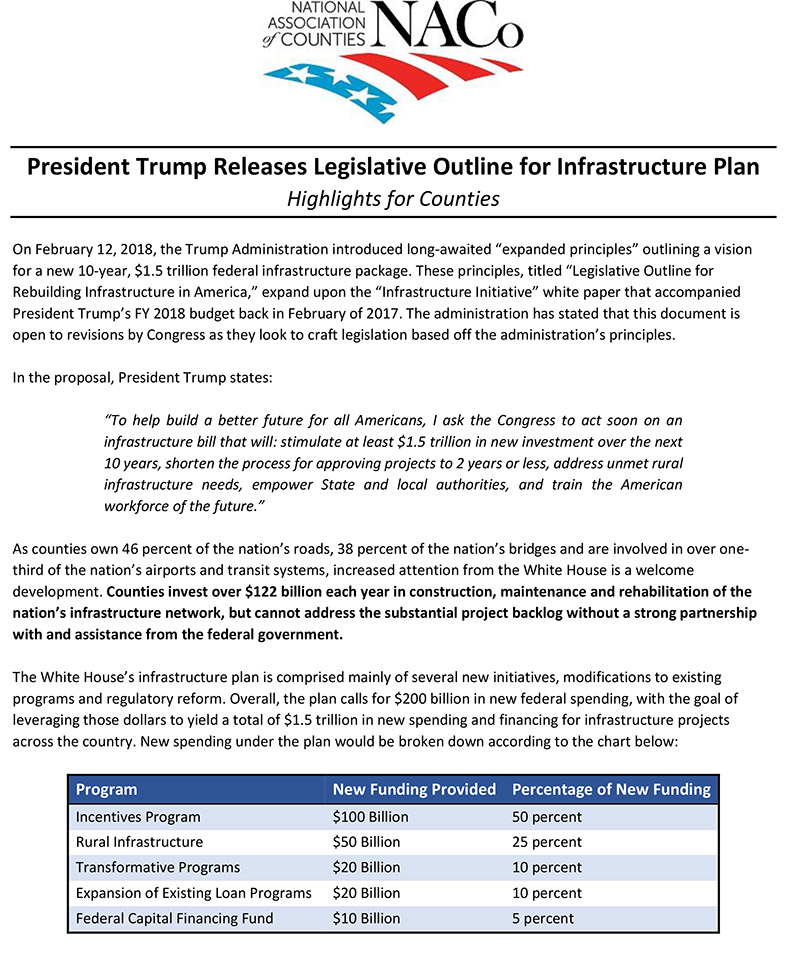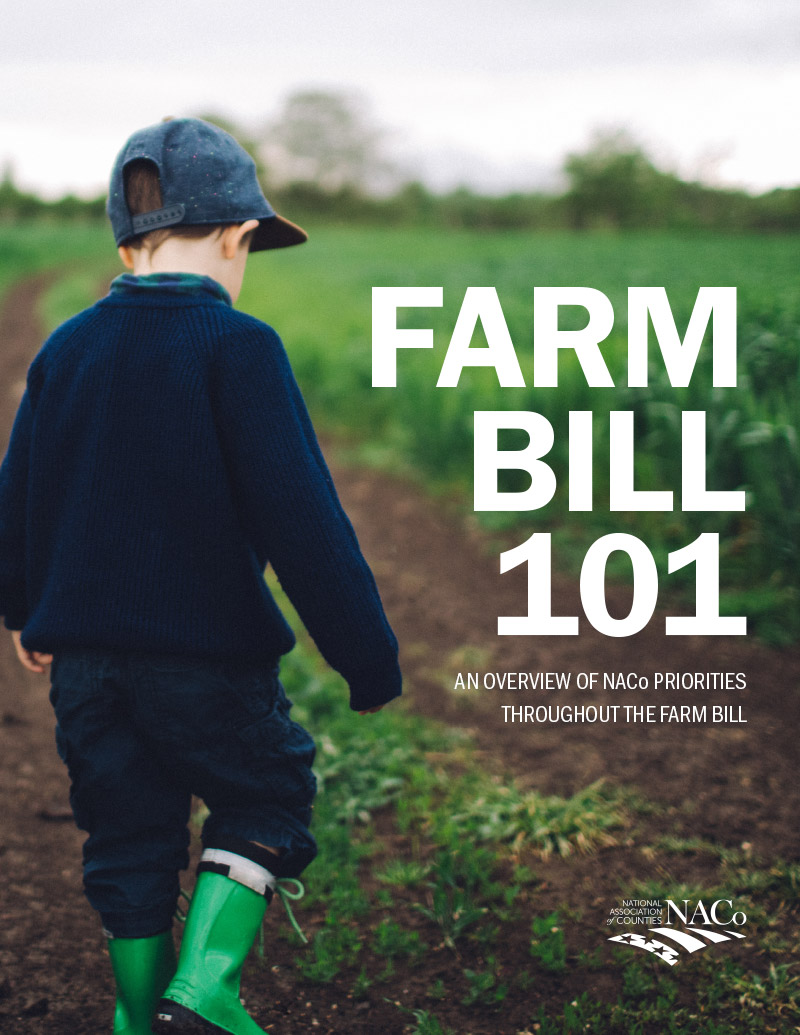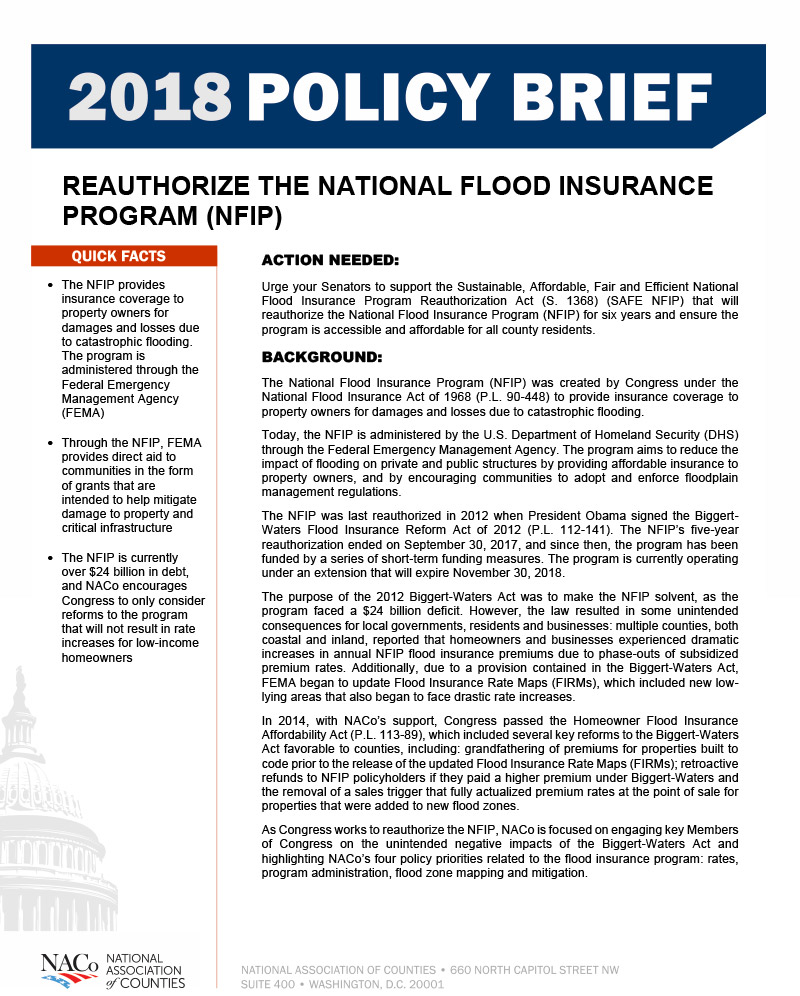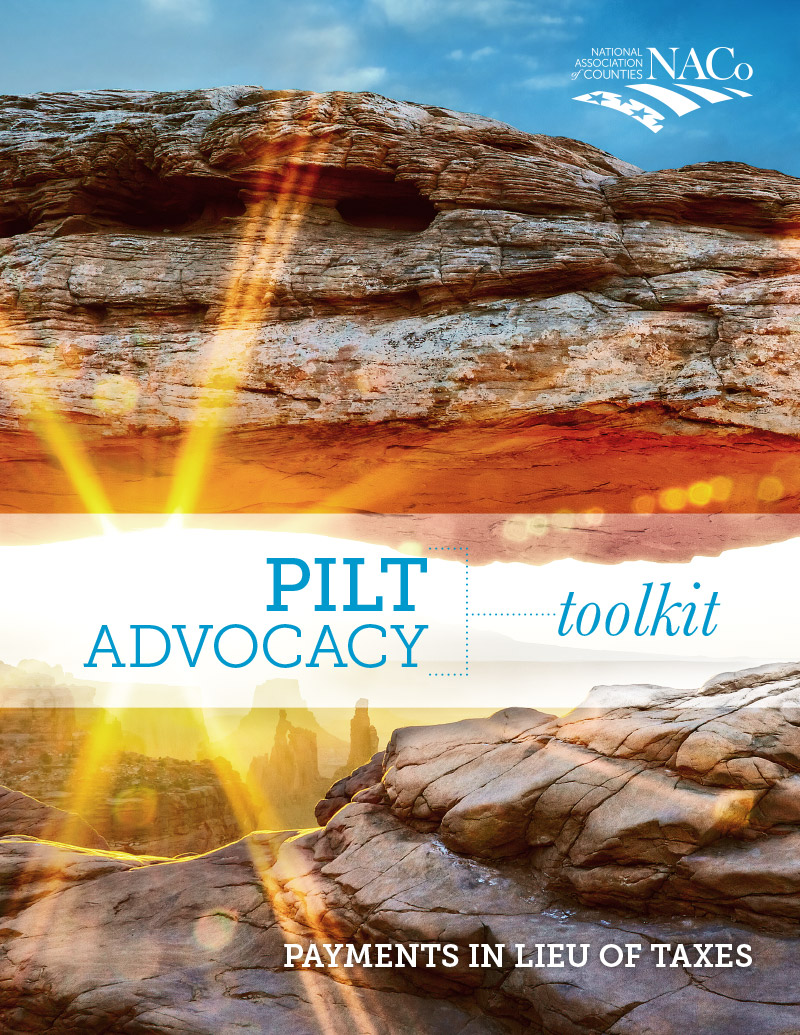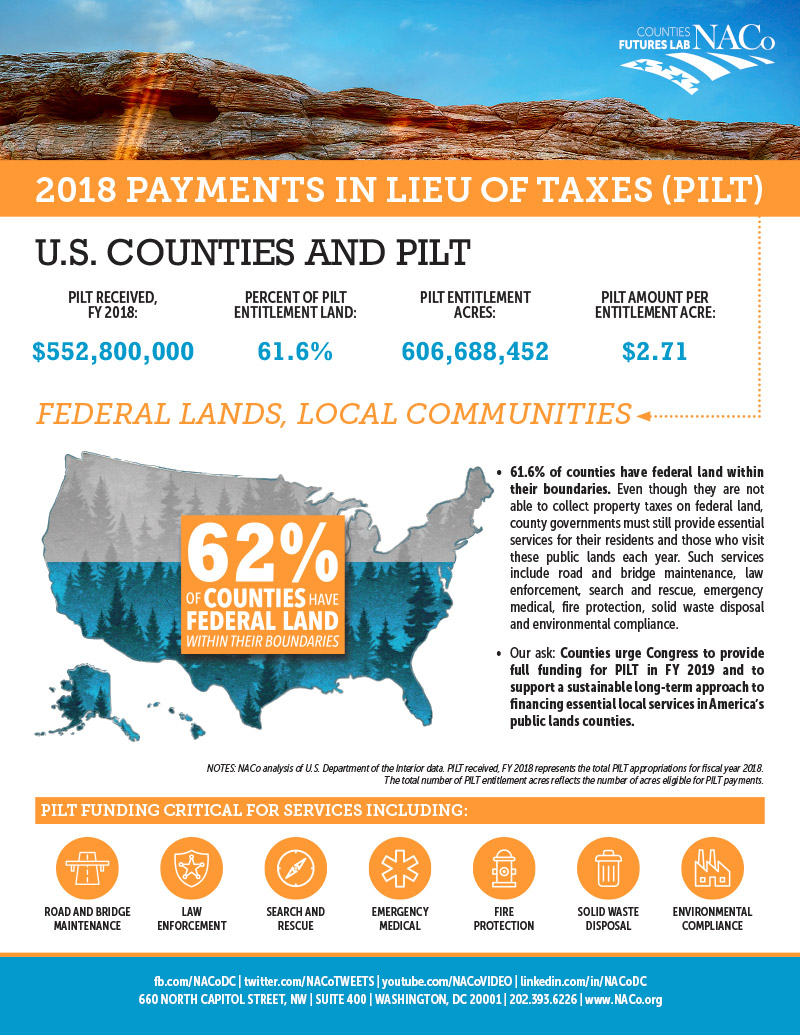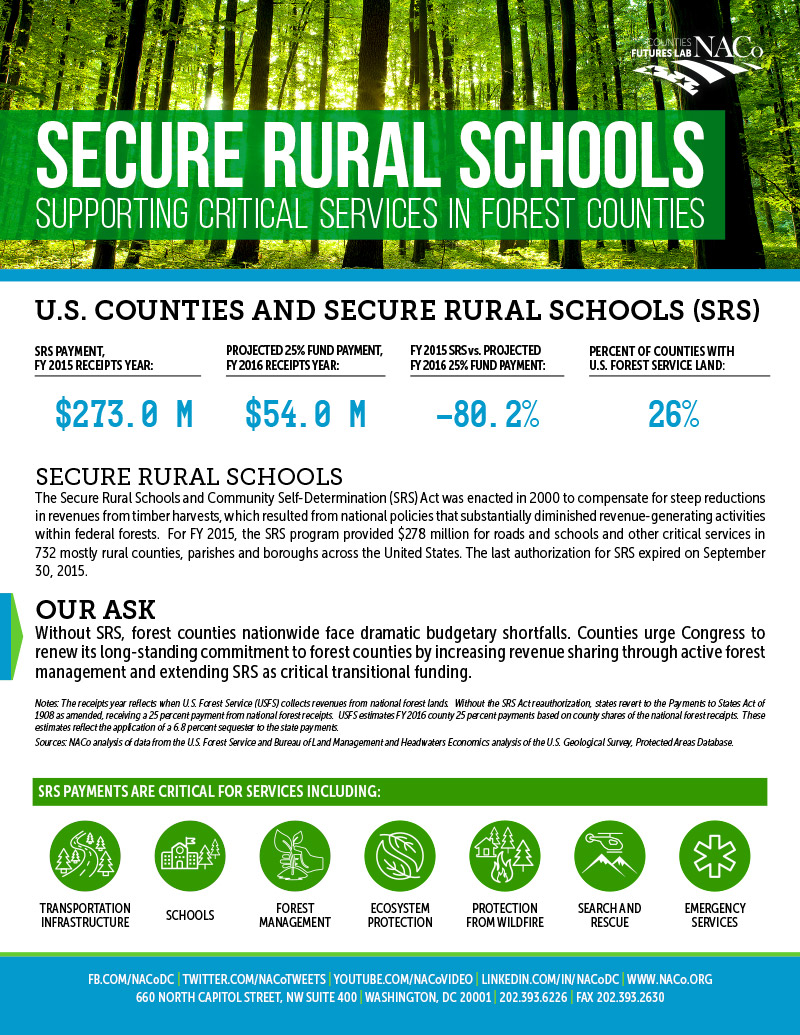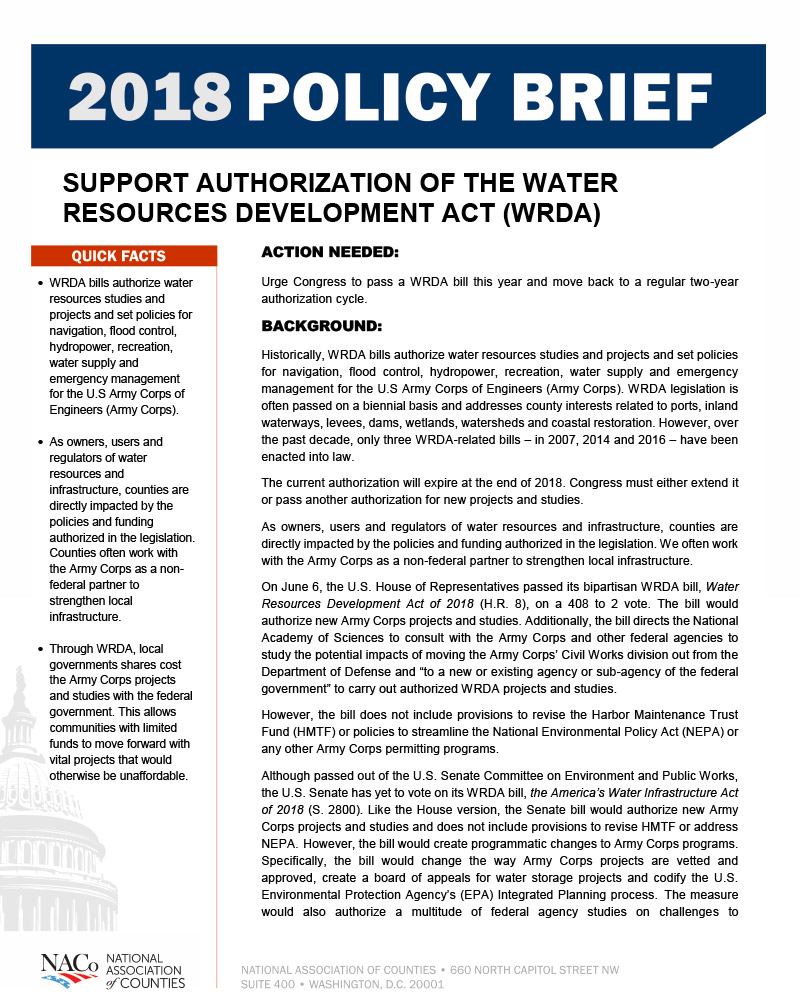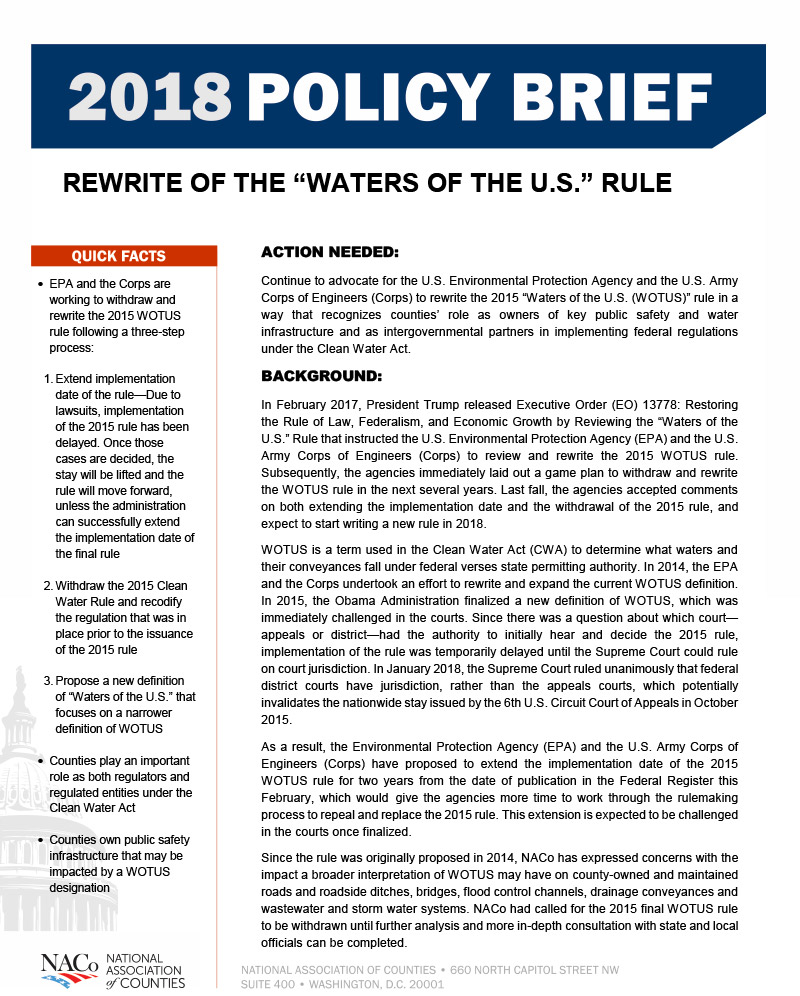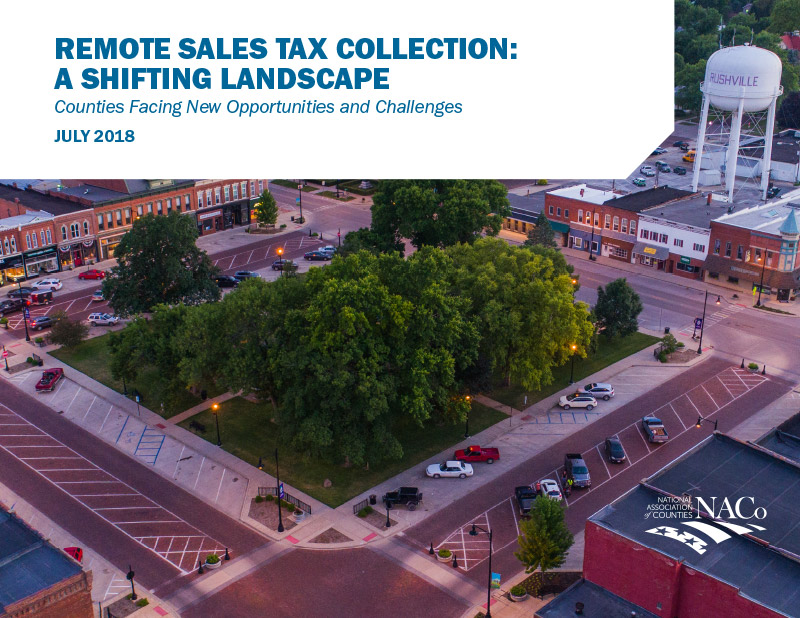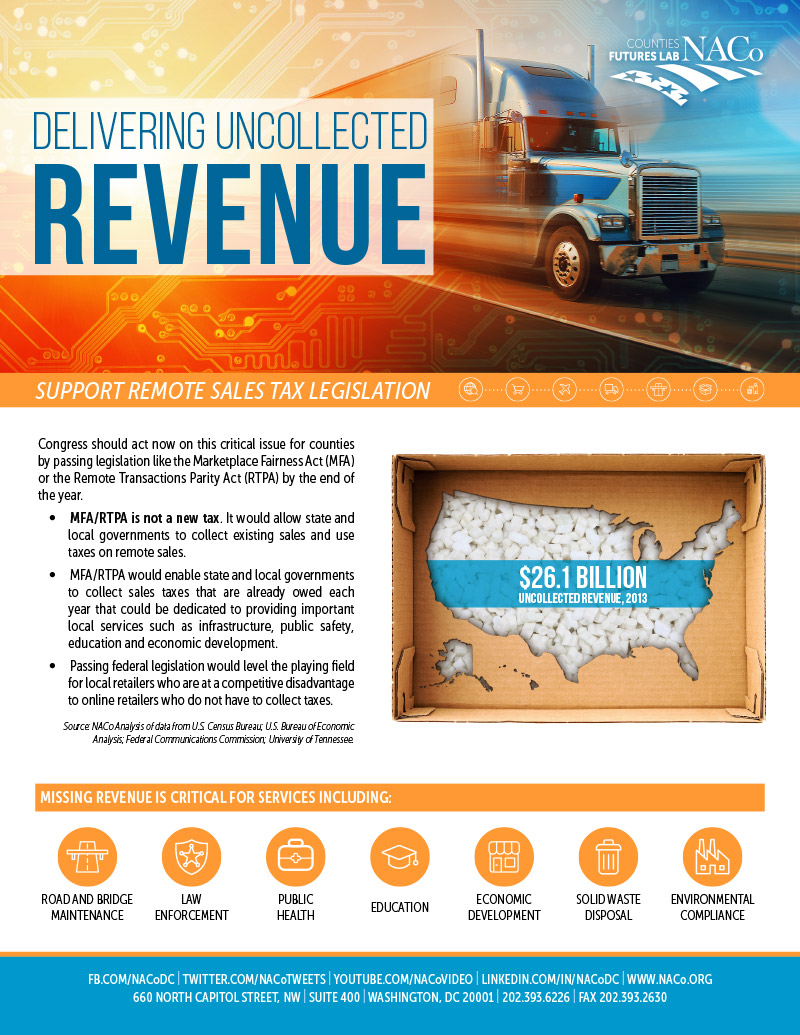2018 Summer Advocacy Toolkit
Upcoming Events
Related News
2018 Summer Advocacy Toolkit
Between now and the end of 2018, members of Congress will be back in their home districts and states for more days than they are in Washington, due in part to the upcoming midterm elections. This break in the federal legislative calendar provides a unique opportunity for county leaders to communicate with legislators, demonstrate the impact of county programs in your communities and advocate for the federal programs that help to strengthen local agencies and initiatives.
As these negotiations are progressing in Congress, NACo has created this Summer Advocacy Toolkit to aid county leaders in advocating for the programs most important to your communities while members of your delegation are in your home states and districts. The toolkit features in-depth information, talking points, media guides and other exclusive NACo materials on county priorities ranging from infrastructure and public lands to remote sales tax and regulatory reform. For additional legislative advocacy materials, including individual policy briefs and presentations, visit www.naco.org/advocacy.
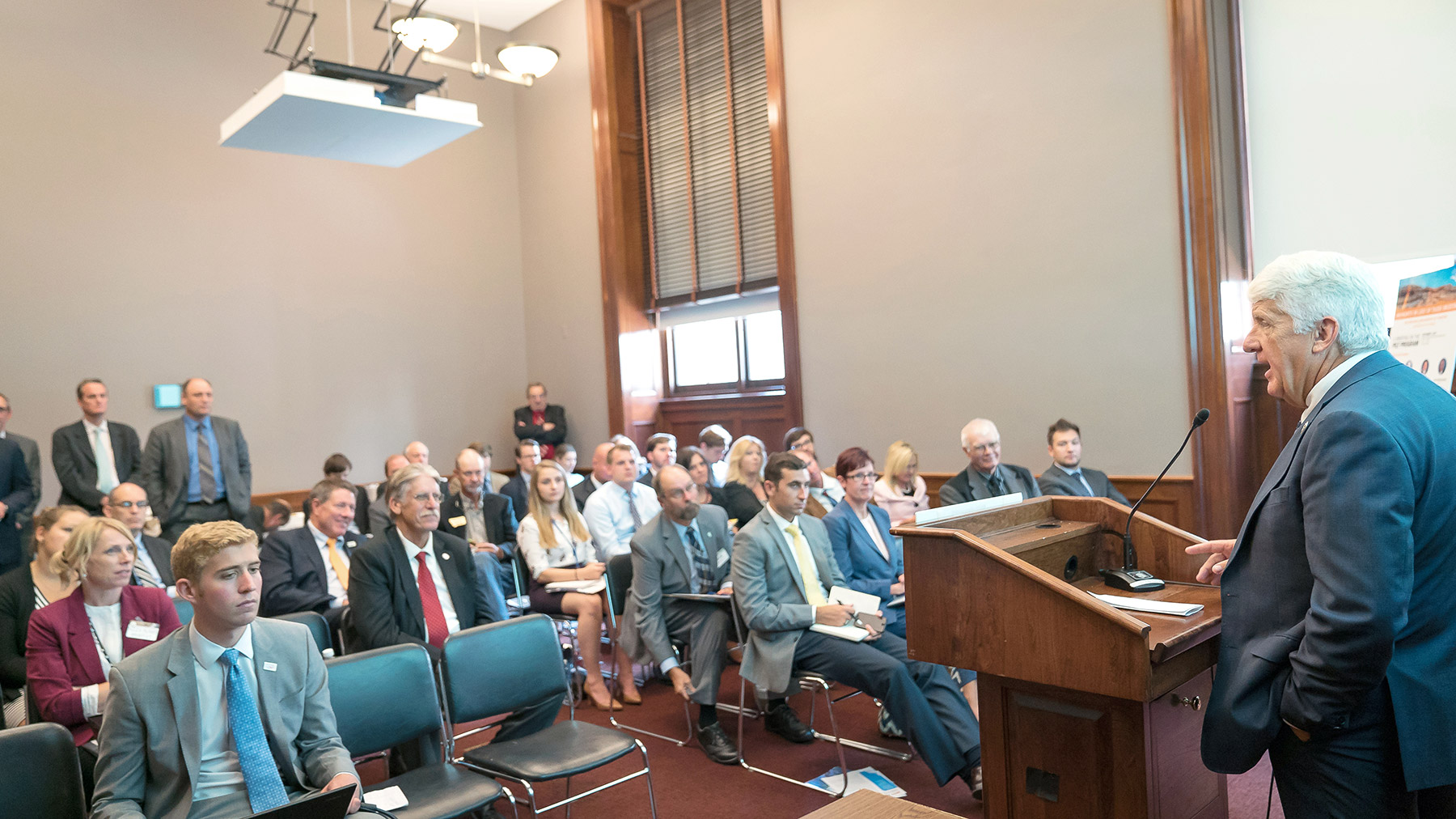
Jump to Section
- Support County Priorities In Any New Federal Infrastructure Package
- Support Key County Priorities As Congress Finalizes Farm Bill
- Support Reauthorization of the National Flood Insurance Program (NFIP)
- Support Full Funding for Payments in Lieu of Taxes (PILT)
- Support Reauthorization of the Secure Rural Schools (SRS) Program
- Support Authorization of the Water Resources Development Act (WRDA)
- Preserve County Interests in Waters of the U.S. (WOTUS) Regulations
- Support the Collection of Existing Sales Taxes on Remote and Online Sales
Counties Matter Fast FactsCounties Invest over over $554 billion annually and employ more than 3.6 million with more than 19,000 elected county board members & elected county executives
Ideas for Advocacy
|
|
Support County Priorities In Any New Federal Infrastructure Package |
Background
Counties play a central role in the nation’s transportation system. We own 46 percent of all public roads and build and maintain 38 percent of the nation’s bridge inventory, 78 percent of all public transit agencies and 34 percent of airports that connect residents, communities and businesses.
In February 2018, President Trump introduced his infrastructure plan, which totaled $1.5 trillion in new spending and financing for infrastructure projects across the country. Since the introduction of the infrastructure plan, the administration has continued to advocate for infrastructure policy designed to create, improve, renovate and repair our nation’s aging infrastructure.
Any new infrastructure package, if realized, could impact counties’ ability to prioritize and advocate for specific projects. While past surface transportation authorizations such as MAP-21 (P.L. 112-141) and the FAST Act (P.L. 114–94) focused on setting policy, the Trump Administration’s infrastructure plan is expected to focus on actual project conception and construction, as well as reducing regulatory barriers to development. The administration has expressed its intent to work with Congress as members introduce infrastructure-related legislation.
County Interest
Counties should be recognized as major owners of infrastructure in any future federal infrastructure package. Furthermore, federal funding levels and local authority should adequately reflect the county role in the nation’s transportation system. Counties believe that a user-pay approach should continue to be the cornerstone of federal transportation funding and that federal policy should provide counties the flexibility to use additional financing tools. Specifically, counties support the following:
New, dedicated federal funding must be part of any new infrastructure package: While counties support public-private partnerships (P3’s) for project development, it is important that any future infrastructure package provide funding to those parts of the country where private investment is not accessible. Any new federal infrastructure package should include a robust rural infrastructure component and a sufficient funding match.
Preserving the tax-exempt status of municipal bonds: Tax-exempt municipal bonds are a critical tool for counties to facilitate the budgeting and financing of long-range investments in infrastructure and facilities necessary to meet public demand. Without the tax exemption, counties would pay more to raise capital, resulting in reduced spending on roads and bridges, decreased economic development, higher taxes or higher user fees. The Tax Cuts and Jobs Act (P.L. 115-97), signed into law in 2017, fully retained the tax-exempt status of all municipal bonds, and counties support the continued preservation of the tax-exempt status for these bonds.
Promoting long-term solvency of the Highway Trust Fund: To maintain a robust infrastructure network, the Highway Trust Fund must remain solvent. NACo advocates for an “all tools in the toolbox” approach to accomplishing this objective, including increased user fees for infrastructure.
Providing an environment for innovative financing: Counties support innovative financing mechanisms including, but not limited to: qualified tax credit bonds; infrastructure banks; the Transportation Infrastructure Finance and Innovation Act (TIFIA); and public-private partnerships that would allow local governments and transportation authorities, such as counties, to leverage federal financing for capital projects.
Streamlining of the federal permit process: Counties support streamlining of the federal permitting process, which can help reduce project delays resulting from duplicative reviews and procedures.
Click here to view NACo’s analysis of President Trump’s Infrastructure Plan
Current Status
Congress and the administration have expressed interest in improving our nation’s infrastructure both through policy and appropriations, such as the FY 2019 Department of Transportation Appropriations and the reauthorization of the Federal Aviation Administration. Additionally, U.S. House Transportation and Infrastructure Committee Chairman Bill Shuster (R-Pa.) recently introduced a new infrastructure proposal that would shore up the solvency of the Highway Trust Fund and extend the FAST Act through FY 2021. While the path forward for Chairman Shuster’s bill is unclear, his proposal, along with the president’s infrastructure plan, could act as a blueprint for Congress and the administration to advance an infrastructure package.
Talking Points
- Any new infrastructure legislation or administrative action should accomplish the following goals:
- Allocate funding for locally owned infrastructure.
- Preserve the tax-exempt status of municipal bonds.
- Streamline the federal permit process.
- Implement policies to promote innovative financing.
- Ensure the long-term certainty and solvency of the Federal Highway Trust Fund.
Relevant Committees with Jurisdiction (find your member):
- U.S. House Committee on Transportation and Infrastructure
- U.S. Senate Committee on Environment and Public Works
- U.S. House Committee on Ways and Means
- U.S. Senate Committee on Commerce, Science and Transportation
|
Support Key County Priorities As Congress Finalizes Farm Bill |
Background
This year, Congress has taken significant steps towards reauthorizing a new farm bill. The current farm bill authorization, the Agriculture Act of 2014 (P.L. 113-79), expires at the end of FY 2018.
The farm bill authorizes a broad range of programs that assist counties in rural development efforts, nutrition assistance programs, conservation initiatives, renewable energy deployment, supporting new farmers and ranchers and aiding business development initiatives.
County Interest
All titles of the farm bill are vitally important to America’s counties. The farm bill should underscore the growing interdependence of rural and urban counties and the common stake each has in ensuring that the assets of rural America are fully optimized.
The farm bill helps counties make critical investments in infrastructure, workforce and economic development and nutrition and conservation for some of our nation’s most underserved communities. Preserving these programs is key to the strength and stability of our local and national economies.
Click here to view NACo’s latest farm bill analysis
Current Status
On June 21, the U.S. House of Representatives passed the Agriculture and Nutrition Action of 2018 (H.R. 2), a five-year, $860 billion farm bill reauthorization package. The Senate followed suit on June 28, amending the House version and passing its own bipartisan farm bill package.
The two bills contain some significant differences: for example, the House bill would eliminate certain conservation programs, including the Conservation Stewardship Program (CSP), and cut the conservation title by $800 million over the next ten years. Under the rural development title, the House bill would create authorities for the Secretary of Agriculture to address emerging rural health crises and forecast speed standards for rural broadband loans. The House version would also make significant changes to the Supplemental Nutrition Assistance Program (SNAP), which serves communities in all counties across the country, and is county administered in ten states.
With the current farm bill set to expire September 30, 2018, the Senate and House joint conference committee must negotiate a package that can be supported by both chambers. Once a final package has been written, both chambers must consider and pass the conferenced bill before the president signs the measure into law.
Talking Points
- The farm bill is critical for counties, which are responsible for delivering vital services to many of our nation’s vulnerable families. It contains programs that assist counties in rural development efforts, nutrition assistance programs, conservation initiatives, renewable energy deployment, support for new farmers and ranchers, and business development initiatives.
- As key intergovernmental partners, county officials understand the importance of bipartisanship and encourage members of the farm bill conference committee to work together to pass a comprehensive and long-term farm bill.
- Counties support the Senate’s approach to the SNAP portion of the farm bill, which protects SNAP benefit levels and eligibility, keeps food on the table for struggling families, makes modest changes to improve program effectiveness and invests in critical employment and training programs to better serve SNAP recipients.
- Urge your members of Congress to support inclusion of the following NACo-supported provisions in the final farm bill being negotiated by the House and Senate:
- Allow counties to exclude incarcerated individuals for population counts for program eligibility under USDA’s definition of “rural.”
- Allow counties to use USDA broadband loans and grants for “middle-mile” projects, which is prohibited under current law.
- Create the Rural Innovation Stronger Economy (RISE) Grant Program to help counties strengthen the local economy through partnerships with the private sector and higher education.
- Reinstate the Undersecretary for Rural Development, which was eliminated in 2017.
- Develop an interagency “Council on Rural Community Innovation and Economic Development” to help leverage federal resources aimed at rural counties.
- Expand the Strategic Economic and Community Development Program, which incentivizes regional collaboration on rural development efforts.
Relevant Committees with Jurisdiction (find your member):
|
Support Reauthorization of the National Flood Insurance Program (NFIP) |
Background
The National Flood Insurance Program (NFIP) was created by Congress under the National Flood Insurance Act of 1968 (P.L. 90-448) to provide insurance coverage to property owners for damages and losses due to catastrophic flooding.
Today, NFIP is administered by the U.S. Department of Homeland Security (DHS) through the Federal Emergency Management Agency (FEMA). The program aims to reduce the impact of flooding on private and public structures by providing affordable insurance to property owners and encouraging communities to adopt and enforce floodplain management regulations.
NFIP was last reauthorized in 2012 when President Obama signed the Biggert-Waters Flood Insurance Reform Act of 2012 (P.L. 112-141). In 2014, with NACo’s support, Congress passed the Homeowner Flood Insurance Affordability Act (P.L. 113-89), which included several key reforms to the Biggert-Waters Act.
The 2012 NFIP reauthorization ended on September 30, 2017, and since then the program has been funded by a series of short-term funding measures. One of the main reasons NFIP has not been fully reauthorized is due to disagreements among members of Congress on how to make the program solvent. Currently, NFIP is estimated to be at least $24 billion in debt. On July 31, 2018, Congress passed a short-term extension to fund NFIP through November 30, 2018.
Click here to view NACo’s policy brief on NFIP
County Interest
Local governments play a key role in NFIP. While making land use and development decisions, counties must recognize and incorporate flood hazards during the decision-making process. For residents to be eligible to participate in NFIP, local governments must comply with NFIP policies when setting and enforcing building codes, approving building permits, regulating water quality and building and maintaining public infrastructure.
Along with providing flood insurance, NFIP helps local governments prepare for natural disasters by allocating funds to develop emergency management and mitigation plans for future flooding events.
As Congress works to pass a long-term reauthorization of NFIP, counties should encourage members of Congress to strengthen and sustain the program and develop policies that will allow for participation from the most vulnerable county residents. This includes restoring premium subsidies for low-income and high-risk residents, and funding for state and local governments to invest in infrastructure improvements that will help to mitigate potential property loss due to a catastrophic flood.
Current Status
During the 115th Congress, there have been multiple proposals to reauthorize and reform NFIP.
In 2017, the U.S. House of Representatives passed legislation to reauthorize NFIP for five years, titled the 21st Century Flood Reform Act (H.R. 2874). The bill would lower the annual cap on premium increases, create a new insurance affordability program allowing states to subsidize premiums for low-income policyholders and enact new reporting requirements for FEMA.
Across the Capitol, the U.S. Senate is considering two major proposals: 1.) the Sustainable, Affordable, Fair, and Efficient National Flood Insurance Program Reauthorization Act (S. 1368) (SAFE NFIP Act) and 2.) the Flood Insurance Affordability and Sustainability Act (S. 1313).
The SAFE NFIP Act, introduced by Sens. Robert Menendez (D-N.J.) and John Kennedy (R-La.), would reauthorize NFIP for six years and provide additional funding to current mitigation assistance grant programs. Alternatively, the Flood Insurance Affordability and Sustainability Act, introduced by Sens. Kristen Gillibrand (D-N.Y.) and Bill Cassidy (R-La.) would reauthorize NFIP for ten years, helping reduce uncertainty in both the housing and insurance markets.
Talking Points
- Congress should enact a long-term reauthorization of the NFIP. When the federal government uses short-term extensions, counties are often unable to effectively plan and implement a workable budget. The NFIP is currently operating under a short-term extension that will expire November 30, 2018.
- Counties support policies that restore premium subsidies for low-income and high-risk residents, as well as funding for state and local governments to invest in infrastructure improvements that will help to mitigate potential property loss due to a catastrophic flood.
- Counties believe that a NFIP reauthorization bill should:
- Enhance National Flood Insurance Program solvency and sustainability
- Enhance flood insurance affordability and accessibility
- Reduce premium costs through an agreed value pilot program
- Provide private market access, accountability and competition
- Modernize flood mapping and flood risk accuracy
- Enhance National Flood Insurance Program transparency and accountability
Relevant Committees with Jurisdiction (find your member):
- U.S. House Committee on Financial Services
- U.S. Senate Committee on Housing, Banking and Urban Affairs
|
Support Full Funding for Payments in Lieu of Taxes (PILT) |
Background
The PILT program was created in 1976 to offset costs incurred by counties for services provided to federal employees and their families, the public and to the users of public lands. Such services include education, solid waste disposal, law enforcement, search and rescue, health care, environmental compliance, fire-fighting, parks and recreation and other important community services.
Annual PILT funding levels remained static for many years. For nearly two decades, counties watched the value of their PILT receipts drop due to inflation. In 1995, NACo was successful in securing an amendment to the PILT formula, (P.L. 103-397), which adjusted annual authorization levels for inflation.
The FY 2018 Omnibus Appropriations package, signed by the president on March 23, 2018, funded PILT at $553 million for the remainder of FY 2018.
Click here to view NACo’s PILT Advocacy Toolkit
In prior fiscal years, the Consolidated Appropriations Act of 2017 fully funded PILT at $465 million for FY 2017, and in FY 2016, Congress fully funded PILT at $452 million. In FY 2015, PILT was funded with $70 million in appropriations provided by the FY 2015 National Defense Authorization Act and $372 million in appropriations provided by the FY 2015 Consolidated and Further Continuing Appropriations Act (P.L. 113-235). Together the two bills provided full discretionary funding of $442 million for PILT in FY 2015. Although full funding was provided in FY 2015, this piecemeal approach subjected a portion of PILT funds to sequestration and required NACo to advocate successfully for a “technical fix” to ensure the distribution of nearly 10 percent of total FY 2015 PILT funds was not delayed into 2016.
County Interest
PILT provides payments to over 1,850 counties in 49 states, the District of Columbia, Guam, Puerto Rico and the U.S. Virgin Islands to offset lost property tax revenues for counties due to the presence of non-taxable federal lands within their jurisdictions. 62 percent of counties have federal lands within their boundaries. Because local governments are unable to tax the property values or products derived from federal lands, PILT payments are necessary to support essential government services (mandated by law) such as education, emergency services, transportation infrastructure, law enforcement and health care.
Current Status
While PILT has been fully funded for the remainder of FY 2018, without predictable mandatory funding, PILT will remain a discretionary program subject to the annual appropriations process. As Congress works through the FY 2019 appropriations process, counties ask the administration and members of Congress to support long term, predictable full funding for PILT in FY 2019 and beyond.
Talking Points
- The PILT program provides payments to counties and other local governments to offset losses in tax revenues due to the presence of substantial federal land acreage within their jurisdictions.
- Because local governments are unable to tax the property values or products derived from federal lands, PILT payments are necessary to support essential local government services (mandated by law) such as education, emergency services, transportation infrastructure, law enforcement and health care in over 1,850 counties in 49 states, the District of Columbia, Guam, Puerto Rico and the U.S. Virgin Islands.
- Without predictable mandatory funding, PILT will remain a discretionary program subject to the annual appropriations process. Counties urge the administration and members of Congress to support long-term predictable full funding for PILT in FY 2019 and beyond.
- While the Senate and House continue to discuss legislative solutions for funding the PILT program, NACo will continue to urge leadership in both chambers and on both sides of the aisle to work together to fully fund the program.
Relevant Committees with Jurisdiction (find your member):
- U.S. House Committee on Natural Resources
- U.S. House Appropriations Subcommittee on Interior and Environment
- U.S. Senate Committee on Energy and Natural Resources
- U.S. Senate Appropriations Subcommittee on Interior and Environment
https://www.youtube.com/embed/16FYZkVDubY?rel=0
|
Support Reauthorization of the Secure Rural Schools (SRS) Program |
Background
The SRS program provides assistance to rural counties and school districts affected by the decline in revenue from timber harvests on federal lands. Historically, rural communities and schools have relied on a share of receipts from timber harvests to supplement local funding for education services and roads. During the 1980s, national policies substantially diminished the revenue-generating activity permitted in these forests. The resulting steep decline in timber sales decreased the revenues that rural counties and school districts received from forest management activities.
In response to this decline, SRS was enacted in 2000 (P.L. 106-393) to stabilize payments to counties and to compensate for lost revenues. In October 2008, SRS was reauthorized (P.L. 110-343) and amended to continue on a sliding payment scale. Most recently, SRS was reauthorized retroactively on March 23, 2018 for FY 2017 and FY 2018. In FY 2017, SRS provided $256 million to over 700 rural counties, parishes and boroughs across the nation. SRS expires at the end of FY 2018, with FY 2018 payments to be made in spring 2019.
County Interest
The SRS program was enacted in 2000 to provide funding for counties and schools to compensate for steep reductions in revenues from timber harvests caused by federal policies. The expiration of SRS will create dramatic budgetary shortfalls if Congress fails to renew this long-standing federal obligation to county governments. Enactment of a sustainable long-term program to share revenues generated from the management of designated federal lands with forest counties and schools will ensure that students receive essential education services and rural communities have critical funding for roads, conservation projects, search and rescue missions and fire prevention programs.
https://www.youtube.com/embed/hGuKzdgumXg?rel=0
Current Status
SRS expires at the end of FY 2018 on September 30, 2018. Although forest counties received their FY 2017 SRS payments in calendar year 2018, the availability of future SRS payments remains in jeopardy. As Congress works through the FY 2019 appropriations process, counties ask the administration and members of Congress to support long term, predictable funding for SRS in FY 2019 and beyond.
Talking Points
- If not reauthorized for FY 2019 and beyond, the expiration of the Secure Rural Schools and Community Self-Determination (SRS) Act at the end of FY 2018 will create budgetary shortfalls for over 700 rural counties across the United States. When the authorization for SRS lapsed in FY 2016, federal forest payments to counties decreased by over 80 percent on average.
- New legislation should be enacted that provides forest revenue sharing payments to counties and promotes active natural resource management for the stability and well-being of forest counties and communities. NACo encourages Congress to act quickly to reauthorize the SRS program, a critical safety-net for forest counties, and improve federal forest management practices.
Relevant Committees with Jurisdiction (find your member):
Visit NACo's County Explorer to download you county's PILT Profile
Visit NACo's County Explorer to download you county's SRS Profile
|
Support Authorization of the Water Resources Development Act (WRDA) |
Background
The Water Resources Development Act (WRDA) authorizes water resources studies and projects and sets policies for navigation, flood control, hydropower, recreation, water supply, ecosystem restoration and emergency management for the U.S Army Corps of Engineers (Army Corps). Historically, WRDA legislation has been passed on a biennial basis. However, over the past decade, only three WRDA-related bills – in 2007, 2014 and 2016 – have been enacted into law. Without authorization, the Army Corps is unable to start new projects or modify existing ones to move forward.
The current WRDA authorization will expire at the end of 2018. Congress must either extend the current authorization or pass another authorization for new projects and studies.
County Interest
As owners, users and regulators of water resources and infrastructure, counties are directly impacted by the policies and funding authorized in WRDA legislation. We often work with the Army Corps as a non-federal partner to strengthen local infrastructure, including by widening levees to prevent flooding, deepening navigation channels in harbors and ports and widening rivers to prevent ice jam related flooding. WRDA bills address a variety of county interests related to ports, inland waterways, levees, dams, wetlands, watersheds and coastal restoration.
Click here to view NACo’s policy brief on WRDA
County Interest
As owners, users and regulators of water resources and infrastructure, counties are directly impacted by the policies and funding authorized in WRDA legislation. We often work with the Army Corps as a non-federal partner to strengthen local infrastructure, including by widening levees to prevent flooding, deepening navigation channels in harbors and ports and widening rivers to prevent ice jam related flooding. WRDA bills address a variety of county interests related to ports, inland waterways, levees, dams, wetlands, watersheds and coastal restoration.
Current Status
On June 6, the U.S. House of Representatives passed its bipartisan WRDA bill, the Water Resources Development Act of 2018 (H.R. 8), on a 408 to 2 vote. The bill would authorize new Army Corps projects and studies. Additionally, the bill directs the National Academy of Sciences to consult with the Army Corps and other federal agencies to study the potential impacts of moving the Army Corps’ Civil Works division from the Department of Defense to a “new or existing agency or sub-agency of the federal government” to carry out authorized WRDA projects and studies.
The U.S. Senate has yet to vote on its WRDA bill, the America’s Water Infrastructure Act of 2018 (S. 2800). Like the House version, the Senate bill would authorize new Army Corps projects and studies. However, the Senate bill would change the way Army Corps projects are vetted and approved, create a board of appeals for water storage projects and codify the U.S. Environmental Protection Agency’s Integrated Planning process. The measure would also authorize studies on various challenges to implementing a Water Infrastructure Financing Innovations Act (WIFIA) program in the Army Corps, examining how WIFIA can be better used by rural, disadvantaged and tribal communities and understanding how the Army Corps can increase transparency with state and local partners.
Talking Points
- As owners, users and regulators of water resources and infrastructure, counties are directly impacted by the policies and funding authorized in WRDA legislation. Counties often work with the Army Corps as a non-federal partner to strengthen local infrastructure.
- NACo supports preserving and maintaining current federal law that provides for federal participation through the U.S. Army Corps of Engineers in a long-standing partnership with state and local governments for funding, implementing and maintaining essential and environmentally sound navigation, harbor, beach management and flow control projects.
- Additionally, as local governments are a key part of the intergovernmental partnership, NACo supports WRDA provisions that require the Army Corps to consult with its state and local partners on projects the Army Corps is considering within an affected jurisdiction.
- Congress and the administration should enact a WRDA bill this year and move back to a two-year authorization cycle.
Relevant Committees with Jurisdiction (find your member):
- U.S. House Committee on Transportation and Infrastructure
- U.S. Senate Committee on Environment and Public Works
|
Preserve County Interests in Waters of the U.S. (WOTUS) Regulations |
Background
Waters of the U.S. (WOTUS) is a term used in the Clean Water Act (CWA) to determine what waters and their conveyances fall under, respectively, federal and state permitting authority. In 2014, the Environmental Protection Agency (EPA) and the U.S. Army Corps of Engineers (Army Corps) undertook an effort to rewrite and expand the current WOTUS definition. In 2015, the Obama Administration finalized a new definition of WOTUS, which was immediately challenged in the courts. Implementation of the 2015 WOTUS is currently delayed nationally as litigation works its way through the court system.
As a result, EPA and the Army Corps have delayed the implementation date of the 2015 WOTUS rule until 2020, giving the agencies more time to work through the rulemaking process to repeal and replace the 2015 rule. This delay has been challenged and is pending in the courts.
County Interest
As owners, users and regulators of water resources and infrastructure, counties are directly impacted by the definition of WOTUS. Since the rule was originally proposed in 2014, counties have expressed concerns with the impact a broader interpretation of WOTUS may have on county-owned infrastructure. Counties own and maintain roads and roadside ditches, bridges, flood control channels, drainage conveyances and wastewater and storm water systems, and act as both regulators and regulated entities under the Clean Water Act. A more expansive WOTUS definition could prove too costly and burdensome for counties.
Click here to view NACo’s policy brief on WOTUS
Current Status
In February 2017, President Trump released Executive Order (EO) 13778: Restoring the Rule of Law, Federalism, and Economic Growth by Reviewing the “Waters of the U.S.” Rule, which instructed the EPA and the Army Corps to review and rewrite the 2015 WOTUS rule. Subsequently, the agencies immediately laid out a plan to withdraw and rewrite the WOTUS rule in the next several years. Last fall, both agencies accepted comments on extending the implementation date and the withdrawal of the 2015 rule and are expected to release a proposed new WOTUS definition in the fall of 2018. Counties support the administration’s efforts to withdraw and rewrite the rule in conjunction with states and local governments to develop consensus around a new WOTUS definition.
Talking Points
- As owners, users and regulators of water resources and infrastructure, counties are directly impacted by the definition of WOTUS.
- Congress, the EPA and the Army Corps should work with state and local governments as they rewrite a new WOTUS rule.
Relevant Committees with Jurisdiction (find your member):
- U.S. House Committee on Transportation and Infrastructure
- U.S. Senate Committee on Environment and Public Works
|
Support the Collection of Existing Sales Taxes on Remote and Online Sales |
Background
On June 21, 2018, the U.S. Supreme Court ruled in South Dakota v. Wayfair that states and local governments can require vendors with no physical presence in a state to collect and remit existing sales taxes on remote or online purchases. The case asked the Court to review its 1992 decision in Quill v. North Dakota, which upheld the “physical presence” standard established in 1967.
Click here to view NACo's primer on Remote Sales Tax
This new ruling enables each state to decide whether to enforce sales tax collection on remote purchases. Under this framework, a state may pass legislation requiring remote sellers to collect these taxes, even if a vendor has no physical presence in the state. If state laws are challenged in court, each state supreme court would determine whether the law is enforceable and consistent with federal law.
County Interest
For counties, lost revenue from online and remote sales means less money for basic services, such as roads and law enforcement officers. The issue of taxing remote sales has compounded in recent years due to the extraordinary development of the Internet as a retail marketplace. State and local governments have lost billions of dollars in uncollected sales taxes over the past few years, and sales in e-commerce are projected to continue increasing. For example, total online sales for Cyber Monday 2017 reached over $6.5 billion, a 16.8 percent increase over the same day in 2016.
With local economies still recovering from the Great Recession, additional revenue will bolster recovery efforts, and capturing these revenues is crucial to counties, especially for mandated yet underfunded services.
Current Status
The U.S. Supreme Court’s decision in South Dakota v. Wayfair promises to give states and local governments access to previously owed but uncollected taxes. Now, counties should work with both their state legislatures and Congress to ensure that local sales and use taxes are included in any tax-related legislation approved at the state or federal level. On the federal level, bipartisan bills have been introduced in both the Senate and the House addressing this issue: the Marketplace Fairness Act (MFA) in the Senate (S. 976) and the Remote Transactions Parity Act (RTPA) in the House (H.R. 2193). NACo supports both pieces of legislation, which would allow states and counties to enforce existing sales tax laws on remote purchases.
Visit NACo's County Explorer to download you county's MFA Profile
If enacted, these bills would create two systems to facilitate multistate sales tax collection: the Streamlined Sales and Use Tax Agreement (SSUTA) and an alternative by which states would collect taxes after adopting minimum simplification requirements for their sales tax laws and administration. The SSUTA, supported by NACo and other state and local government organizations, is a multistate compact that seeks to reduce the complexity of state and local sales and use tax laws and would permit the collection of sales and use taxes from remote sellers. Many states, local governments and the business community were involved in cooperative efforts to simplify sales and use tax collection, which led to the establishment of the Agreement. 24 states are currently members or partial members of the Agreement.
The Agreement minimizes costs and administrative burdens on retailers that collect sales tax, particularly retailers operating in multiple states. It encourages remote sellers to collect taxes on sales to customers living in the 24 member states and levels the playing field so that local stores and remote sellers operate under the same rules. The Agreement ensures that all retailers can conduct their business in a fair, competitive environment.
Talking Points
- Remote sales tax legislation would not result in new taxes, it would allow state and local governments to collect existing sales and use taxes on remote sales.
- Remote sales tax legislation would enable state and local governments to collect sales taxes that are already owed each year and could provide important local services such as infrastructure, public safety, education and economic development.
- Passing federal legislation would level the playing field for local retailers who are at a competitive disadvantage to online retailers who do not have to collect taxes.
Relevant Committees with Jurisdiction (find your member):
NACo’s Additional Resources
SUPPORT COUNTY PRIORITIES IN ANY NEW INFRASTRUCTURE PACKAGE
- Click Here to View NACo’s Policy Brief on County Priorities in Any New Federal Infrastructure Package
- Click Here to View NACo’s Analysis of President Trump’s Infrastructure Plan
SUPPORT KEY COUNTY PRIORITIES AS CONGRESS FINALIZES FARM BILL
- Click Here to View NACo’s Policy Brief on the Farm Bill
- Click Here to View NACo’s Farm Bill 101: An Overview of NACo Priorities Throughout the Farm Bill
SUPPORT REAUTHORIZATION OF THE NATIONAL FLOOD INSURANCE PROGRAM (NFIP)
SUPPORT FULL FUNDING FOR PAYMENTS IN LIEU OF TAXES (PILT)
- Click Here to View NACo’s Policy Brief on PILT
- Click Here to View NACo’s Presentation on PILT
- Click Here to View NACo’s PILT Advocacy Toolkit
- Click Here to View Individual County PILT Profiles
- Click Here to View NACo’s Video on PILT
SUPPORT REAUTHORIZATION OF THE SECURE RURAL SCHOOLS (SRS) PROGRAM
- Click Here to View NACo’s Policy Brief on SRS
- Click Here to View individual State SRS profiles
- Click Here to View NACo’s Video on PILT and SRS
SUPPORT AUTHORIZATION OF THE WATER RESOURCES DEVELOPMENT ACT (WRDA)
PRESERVE COUNTY INTERESTS IN WATERS OF THE U.S. (WOTUS) REGULATIONS
SUPPORT THE COLLECTION OF EXISTING SALES TAXES ON REMOTE AND ONLINE SALES
- Click Here to View NACo’s Policy Brief on Remote Sales Taxes
- Click Here to View NACo’s Presentation on Remote Sales Tax
Media ToolkitWhile members of Congress are in their states and districts during the summer and fall district work periods, county officials have a great opportunity to draw attention to key federal policy issues that impact your county. In addition to inviting your members of Congress for an in-person tour or meeting, your local media outlets are another key advocacy tool. They provide a useful way to keep your residents informed about what you are doing on their behalf. There are many ways to work with your local media, including issuing a press release to inform your community about a congressional visit to your county projects and facilities. Submitting an op-ed or a guest commentary to local papers is also an excellent way to express your views in a highly visible way. To assist you, NACo has developed a Media Relations Guide for Counties​ that provides tools and tips on how to best work with local media outlets. |
